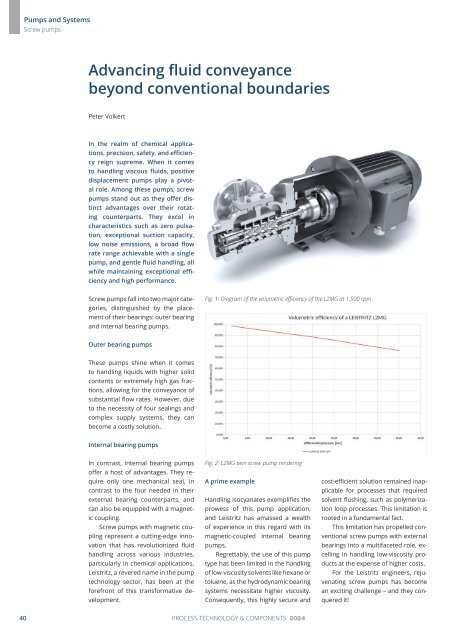PuK - Process Technology & Components 2024
A technical trade magazine with a history of more than 60 years.
A technical trade magazine with a history of more than 60 years.
Create successful ePaper yourself
Turn your PDF publications into a flip-book with our unique Google optimized e-Paper software.
Pumps and Systems<br />
Screw pumps<br />
Advancing fluid conveyance<br />
beyond conventional boundaries<br />
Peter Volkert<br />
In the realm of chemical applications,<br />
precision, safety, and efficiency<br />
reign supreme. When it comes<br />
to handling viscous fluids, positive<br />
displacement pumps play a pivotal<br />
role. Among these pumps, screw<br />
pumps stand out as they offer distinct<br />
advantages over their rotating<br />
counterparts. They excel in<br />
characteristics such as zero pulsation,<br />
exceptional suction capacity,<br />
low noise emissions, a broad flow<br />
rate range achievable with a single<br />
pump, and gentle fluid handling, all<br />
while maintaining exceptional efficiency<br />
and high performance.<br />
Screw pumps fall into two major categories,<br />
distinguished by the placement<br />
of their bearings: outer bearing<br />
and internal bearing pumps.<br />
Fig. 1: Diagram of the volumetric efficiency of the L2MG at 1,500 rpm<br />
Outer bearing pumps<br />
These pumps shine when it comes<br />
to handling liquids with higher solid<br />
contents or extremely high gas fractions,<br />
allowing for the conveyance of<br />
substantial flow rates. However, due<br />
to the necessity of four sealings and<br />
complex supply systems, they can<br />
become a costly solution.<br />
Internal bearing pumps<br />
In contrast, internal bearing pumps<br />
offer a host of advantages. They require<br />
only one mechanical seal, in<br />
contrast to the four needed in their<br />
external bearing counterparts, and<br />
can also be equipped with a magnetic<br />
coupling.<br />
Screw pumps with magnetic coupling<br />
represent a cutting-edge innovation<br />
that has revolutionized fluid<br />
handling across various industries,<br />
particularly in chemical applications.<br />
Leistritz, a revered name in the pump<br />
technology sector, has been at the<br />
forefront of this transformative development.<br />
Fig. 2: L2MG twin screw pump rendering<br />
A prime example<br />
Handling isocyanates exemplifies the<br />
prowess of this pump application,<br />
and Leistritz has amassed a wealth<br />
of experience in this regard with its<br />
magnetic-coupled internal bearing<br />
pumps.<br />
Regrettably, the use of this pump<br />
type has been limited in the handling<br />
of low-viscosity solvents like hexane or<br />
toluene, as the hydrodynamic bearing<br />
systems necessitate higher viscosity.<br />
Consequently, this highly secure and<br />
cost-efficient solution remained inapplicable<br />
for processes that required<br />
solvent flushing, such as polymerization<br />
loop processes. This limitation is<br />
rooted in a fundamental fact.<br />
This limitation has propelled conventional<br />
screw pumps with external<br />
bearings into a multifaceted role, excelling<br />
in handling low-viscosity products<br />
at the expense of higher costs.<br />
For the Leistritz engineers, rejuvenating<br />
screw pumps has become<br />
an exciting challenge – and they conquered<br />
it!<br />
40 PROCESS TECHNOLOGY & COMPONENTS <strong>2024</strong>

















